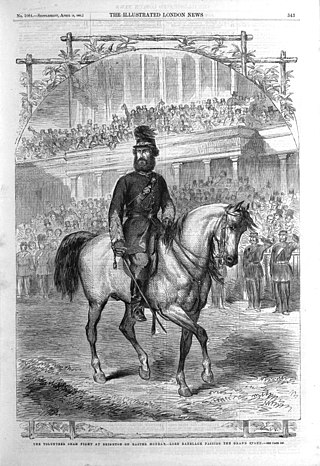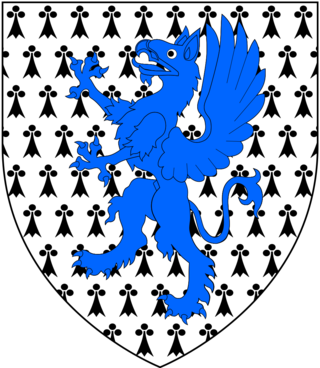This article needs additional citations for verification .(January 2014) |
| |||||
| Centuries: | |||||
|---|---|---|---|---|---|
| Decades: | |||||
| See also: | Other events of 1677 List of years in Ireland | ||||
Events from the year 1677 in Ireland.
This article needs additional citations for verification .(January 2014) |
| |||||
| Centuries: | |||||
|---|---|---|---|---|---|
| Decades: | |||||
| See also: | Other events of 1677 List of years in Ireland | ||||
Events from the year 1677 in Ireland.

Earl of Longford is a title that has been created twice in the Peerage of Ireland.
The Peerage of the United Kingdom is one of the five Peerages in the United Kingdom. It comprises most peerages created in the United Kingdom of Great Britain and Ireland after the Acts of Union in 1801, when it replaced the Peerage of Great Britain. New peers continued to be created in the Peerage of Ireland until 1898

The titles of Earl of Hertford and Marquess of Hertford have been created several times in the peerages of England and Great Britain.

Earl of Rosse is a title that has been created twice in the Peerage of Ireland, both times for the Parsons family. "Rosse" refers to New Ross in County Wexford.

Garret Colley Wesley, 1st Earl of Mornington was an Anglo-Irish politician and composer, as well as the father of several distinguished military commanders and politicians of Great Britain and Ireland.

Viscount FitzWilliam, of Merrion in the County of Dublin, was a title in the Peerage of Ireland. It was created in 1629 for Thomas FitzWilliam, along with the subsidiary title Baron FitzWilliam, of Thorncastle in the County of Dublin, also in the Peerage of Ireland. He was succeeded by his son Oliver, the second Viscount. In 1661 Oliver was created Earl of Tyrconnell in the Peerage of Ireland. The earldom became extinct on his death in 1667, but he was succeeded in the barony and viscountcy by his younger brother William FitzWilliam, the third Viscount. William's grandson Richard, the fifth Viscount, represented Fowey in the British Parliament. His son Richard, the sixth Viscount, was a member of both the Irish and English Privy Councils. The seventh Viscount was a benefactor and musical antiquarian. The titles became extinct on the death of the ninth Viscount in 1833.

Viscount Ranelagh was a title in the Peerage of Ireland. It was created on 25 August 1628 for Sir Roger Jones, son of Thomas Jones, Archbishop of Dublin and Lord Chancellor of Ireland. He was made Baron Jones of Navan, in the County of Meath, at the same time also in the Peerage of Ireland. Thomas Jones's father was Henry Jones, of Middleton in Lancashire. The first Viscount was succeeded by his eldest son, Arthur, the second Viscount, who represented Weobly in the English Parliament. Arthur was succeeded by his son, Richard, the third Viscount, who was created Earl of Ranelagh in the Peerage of Ireland in 1677. On Richard's death in 1712 the earldom became extinct while the barony and viscountcy became dormant.

Richard Jones, 1st Earl of Ranelagh, known as The Viscount Ranelagh between 1669 and 1677, was an Irish peer, politician both in the Parliaments of England and Ireland.
The Lord High Treasurer of Ireland was the head of the Exchequer of Ireland, and chief financial officer of the Kingdom of Ireland. The designation High was added in 1695.
Events from the year 1620 in Ireland.

Francis Aungier, 1st Baron Aungier of Longford (1558–1632), also known as Lord Aungier, was the progenitor of the Earldom of Longford, member of the House of Lords, Privy Councillor for Ireland and Master of the Rolls in Ireland under James I and Charles I.
Sir William Parsons, 1st Baronet of Bellamont, PC (Ire), was known as a "land-hunter" expropriating land from owners whose titles were deemed defective. He also served as Surveyor General of Ireland and was an undertaker in several plantations. He governed Ireland as joint Lord Justice of Ireland from February 1640 to April 1643 during the Irish rebellion of 1641 and the beginning of the Irish Confederate War.

Francis Aungier, 1st Earl of Longford PC (Ire) was an English politician, who sat in the House of Commons from 1660 to 1679. He was an administrator in Ireland.

The Board of Ordnance in the Kingdom of Ireland (1542–1800) performed the equivalent duties of the British Board of Ordnance: supplying arms and munitions, overseeing the Royal Irish Artillery and the Irish Engineers, and maintaining the fortifications in the island.
Elizabeth Pakenham, 1st Countess of Longford, formerly Elizabeth Cuffe, was an Irish noblewoman. She was the wife of Thomas Pakenham, 1st Baron Longford, the mother of Edward Michael Pakenham, 2nd Baron Longford, and the grandmother of Thomas Pakenham, 2nd Earl of Longford.
Events from the year 1676 in Ireland.
Villiers is an aristocratic family in the United Kingdom. Over time, various members of the Villiers family were made knights, baronets, and peers. Peerages held by the Villiers family include the dukedoms of Buckingham (1623–1687) and Cleveland (1670–1709), as well as the earldoms of Anglesey (1623–1661), Jersey, and Clarendon. Perhaps the most prominent members of the family were those who received the two dukedoms: George Villiers, 1st Duke of Buckingham (1592–1628) rose to fame and influence as favourite of King James I of England, while Barbara Villiers, Duchess of Cleveland (1640–1709) became a mistress of King Charles II of England, by whom she had five children.
Henry Moore, 1st Earl of Drogheda PC (I) was an Anglo-Irish peer, politician and soldier.
Hercules Langford Rowley PC was an Irish politician and landowner.